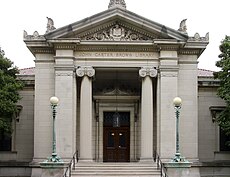John Carter Brown Library

John Carter Brown Library
|
|
| Country | United States |
|---|---|
| Type | Academic library |
| Scope | History and Humanities |
| Established | Mid-1800's |
| Location | Brown University in Providence, Rhode Island |
| Coordinates | 41°49′34″N 71°24′12″W / 41.8262°N 71.4032°W |
| Collection | |
| Items collected | Books |
| Size | 50,000 |
| Website | www |
The John Carter Brown Library is an independently funded research library of history and the humanities, part of Brown University in Providence, Rhode Island. The Library is recognized as possessing one of the world’s finest collections of rare books and maps relating to the European discovery, exploration, settlement, and development of the New World until c. 1820.
The Library originated in the mid-nineteenth century when it began as the private collection of John Carter Brown (1797–1874) who conceived of it being a collection of books written about the discovery of the New World, rather than a gentleman’s financial investment or a rich man’s adornment. This enlightened and pioneering collecting passion was transmitted to his son, John Nicholas Brown (1861–1900). Until John Nicholas Brown’s untimely death, the John Carter Brown Library was kept in a special fireproof room in the Brown family house in the 1792 Nightingale-Brown House. The will of John Nicholas Brown directed that within four years of his death, his trustees were to establish the collection, together with a building to house it, at a permanent site of their choice. They selected Brown University (named in honor of John Carter Brown’s father, Nicholas Brown, Jr.).
The collection of the John Carter Brown Library consists of more than 50,000 books written about both North and South America until roughly the end of the colonial era in the Americas, as well as around 16,000 specialized reference books providing supplementary information about the Library’s holdings. The Library also holds a major collection of prints, manuscripts, and maps of the New World.
The collection of the John Carter Brown Library begins chronologically with fifteenth-century editions of Columbus’s celebrated “letter” to the Spanish court announcing the discovery of lands to the west. The Library houses one of the largest collections of books printed in British North America before 1800, the world’s most complete collection of Mexican works printed before 1600, the largest collection of printed works relating to Brazil before 1820, the finest collection of printed sources for the study of early Canada and the Caribbean to be found in the United States, nearly three-quarters of all known imprints in the native languages of North and South America from the colonial period, and the largest collection of political pamphlets produced at the time of the American revolution.
The Library also holds many important maps and prints relating to the New World. These maps include one of the first printed attempts to depict America in cartographic form (the so-called Stevens-Brown map, a prototype of the 1513 Ptolemy Orbis Typus); the first printed map of Hernán Cortés’s Mexico City, built on the ruins of the Aztec capital, Tenochtitlán; the earliest known printed plan of a European settlement in what is now the United States (a plan of Fort Caroline built by Huguenot settlers in1565 near present-day Jacksonville, Florida); and one of the earliest maps to show the French exploration of the Mississippi River, attributed to Louis Joliet.
...
Wikipedia
